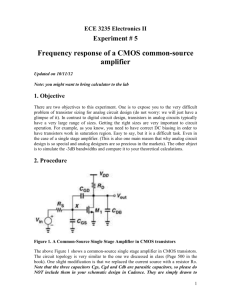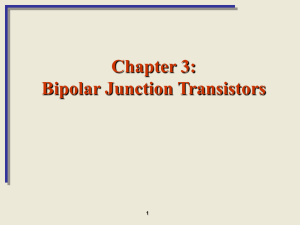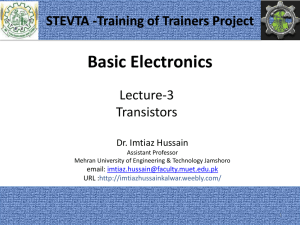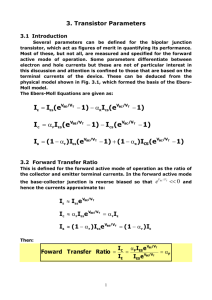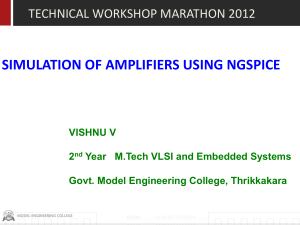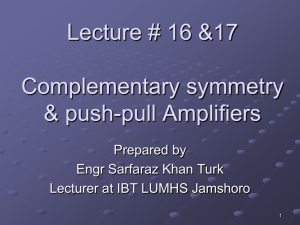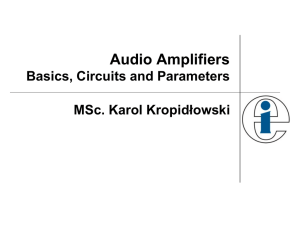transistor
advertisement
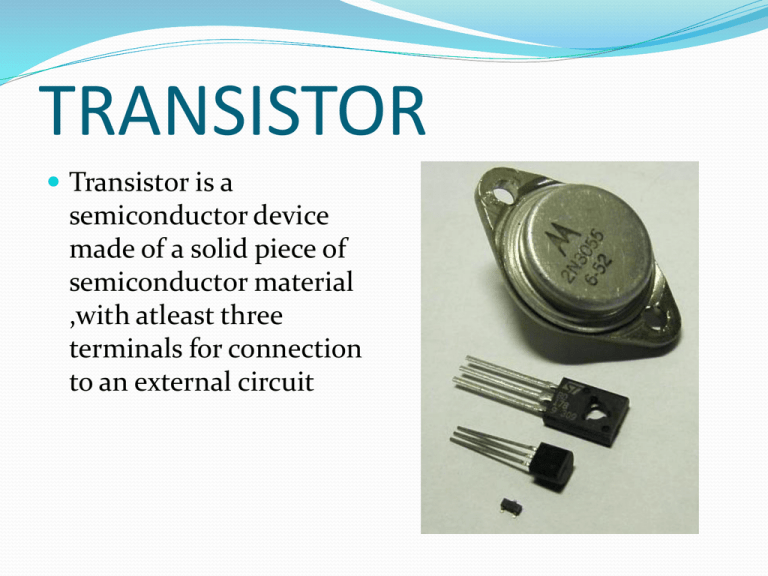
TRANSISTOR Transistor is a semiconductor device made of a solid piece of semiconductor material ,with atleast three terminals for connection to an external circuit TYPES Semiconductor device-germanium ,silicon, gallium arsenide ,silicon carbide etc. Structure – BJT ,JFET ,IGFET(MOSFET) ,IGBT. Polarity – NPN ,PNP(BJT’S); N-Channel,Pchannel(FET’S). Maximum power rating – Low ,Medium ,High APPLICATIONS TRANSISTOR : As an switch As an amplifier As an oscillator TRANSISTOR AS A SWITCH When the switch is in open position, there will be no potential difference between the base and the emitter. •The depeltion region across the emitter-base junction is large. •No current flows through it. •The transistor is off. TRANSISTOR AS A SWITCH When the transistor is off: The emitter -collector terminal acts like an open. The supply of 10 volts drops across the collector output. In this condition, the transistor is reffered to as being in cut-off. When the switch is in open position, a voltage is present across base-emitter junction. •The depletion region across the emitter-base junction shrinks as much as possible. •Thee transistor turn on as hard it can. •Maximum current flows through it. TRANSISTOR AS A SWITCH In this condition transistor is reffered to as being in saturation. The collector-emitter terminal acts like a closed switch. 0 volts drop across the output, causing 10 volts to drop across the load resistor. An amplifier is a device which is used for increasing the amplitude of variation of alternating voltage or current or power. The amplifier thus produces an enlarged version of the input signal. There are two input terminals for the signal to be amplified and two output terminals for the connecting the load and a means of supplying power to the amplifier. From mobile phones to televisions, vast number of products include amplifiers for sound reproduction, radio transmission, and signal processing .The first discrete transistor audio amplifiers barely supplied a few hundred milliwats, but power and audio fidelity gradually increased as better transistor became available and amplifier architecture evolved. Transistors are commonly used in modern musical instrument amplifiers, where circuit upto a few hundred watts are common and relatively cheap. It has largely replaced valves in instrument amplifiers. The BASIC TRANSISTOR AMPLIFIER amplifies by producing a large change in collector current for a small change in base current. This action results in voltage amplification because the load resistor placed in series with the collector reacts to this large changes in collector current which, in turn , results in large variation in the output voltage. CLASS OF AMPLIFIERS The class of amplifier operation is determined by the portion of the input signal for which there is an output Class ‘A’ amplifiers : These are biased so that variation in input signal polarities occur within the limits of cut-off and saturation .Biasing an amplifier in this manner allows collector current to flow during the complete cycle(360 degrees) of the input signal, thus providing an output which is the replica of the input but 180 degrees out of phase. Class ‘AB’ amplifier : These are biased so that collector current is zero (cutoff) for a portion of one alternation of the input signal. These collector current will flow for more than 180 degrees but less than 360 degrees of the input signal. The class ‘AB’ amplifier is commonly used as a push-pull amplifier to overcome a side effect of class B operations. Class ‘B’ amplifier : These are biased so that so that collector current is cut off during one half of the input signal. Thus, for a class B operation, collector current will flow for approximately 180 degrees(half) of the input signal. The class ‘B’ operated amplifier is used as an audio amplifier and as the driver-and power amplifier stage of transmitters. Class ‘C’ amplifier : These are biased so that collector current flows for less than one half cycle of the input signal. The Class ‘C’ amplifier is used as a radio frequency amplifier in transmitters. TRANSISTOR AS AN OSCILLATOR A simple L-C circuit can be used to produce electrical oscillation of desired frequency. The radio waves which are used as carrier waves in radio communications are produced by this circuit called oscillators. Tank circuit consisting of an inductance L and a capacitor C, connected in parallel is the simplest type of electrical oscillating system. In this circuit electrical energy once given to the circuit, oscillates as magnetic energy in the inductance and electrostatic energy in the capacitance . Due to internal resistance of the inductance coil etc. there occurs a small but constant energy loss and hence the oscillation produced are damped. The damped waves are suitable for the transmission of code messages but to transmit speech or music, we require undamped electronic waves or carrier waves. The same can be produced by transistor as an oscillator. TRANSISTOR AS AN OSCILLATOR The advantages that allowed transistors to replace vaccum tubes are : •Small size and minimul weight •Less power consumption •More rugged •Lower voltages •Less heat •Greater reliability The “first generation” of computers used vaccum tubes which generated large amounts of heat and were bulky and unreliable.?The development of the transistor was the key to computer miniaturization and reliability. The “second generation” of the computers, through the late 1950’s and 1960’s featured boards filled with individual transistors and magnetic memory cores. Subsequently transistor, other components and their necessary wiring were integrated into a simple, mass manufactured component : the integrated circuit. Transistors incorporated into integrated circuit. Transistors incorporated into IC have replaced most discrete transistors in modern digital computers.

